He murdered Saint Adalbert. He baptized Poland. And he almost died in an attack. And besides ... he was not nicknamed "Chrobry" at all.
As always, all items in the TOP10 ranking are based on the articles we publish. This time we set out to show you the remarkable and little known facts about our first crowned ruler.
Who would have expected Bolesław the Brave ...
10. He started the true Christianization of Poland
The French chronicler Adémar of Chabannes claimed that Christianity came to Poland ... only with Saint Wojciech and that it was the wandering bishop who baptized Bolesław the Brave. There are many more similar messages. The Duchess of Lorraine, Matylda, called Brave the "source" of Polish Christianity. Even the epitaph on Bolesław's tombstone stated that he was born "of a pagan father."
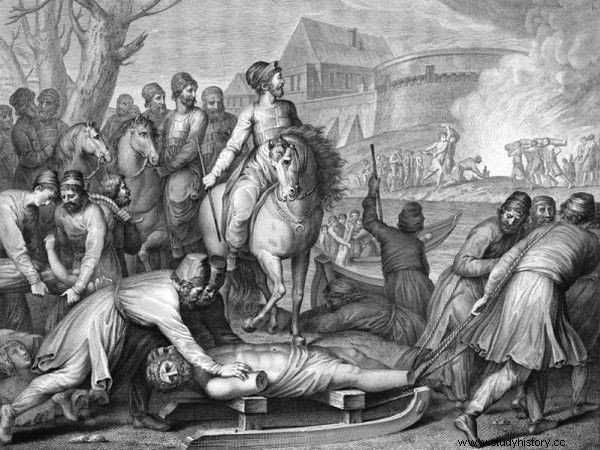
The vision of Mieszko I as a fierce enemy of the old deities and a determined promoter of the Christian faith among the Polish people should be put among fairy tales (source:public domain).
There is a lot of truth in these sources. In 966, not all of Poland was baptized, but only Prince Mieszko and his court. Nobody tried to reach out with faith to the common people. Bolesław's father tolerated the religious freedom of his subjects.
The situation began to change only during the reign of Brave. This ruler had adulterers nailed to the scrotum of bridges, and people who broke their fasts would knock out their teeth. He also brought a group of hermits to Poland from all over Italy. He did everything to prove that he was the first truly Christian prince east of the Oder (read more on this) .
9. He sent an Imperial friend to certain death
Bolesław made efforts to please Otto III. The emperor was a deeply religious young man, and our cunning prince took full advantage of it. To impress Otto, he received in Poland with all honors Bishop Wojciech Sławnikowic. He showed him great hospitality, but did not offer him any warm job. On the first occasion, sent him on a mission of death.

This is how Wojciech's martyrdom was imagined by the creators of the Gniezno Doors (source:public domain).
Wojciech was to convert the Prussians:the wildest and ruthless of the tribes with which Poland bordered. Since Bolesław directed the bishop there, and not, for example, to Małopolska or even Pomerania, then he had to take into account that the missionary would not return. Perhaps this was what he had been quietly expecting. The further development of events shows that Wojciech's defeat was in the best interest of the Polish ruler.
Bolesław began to profit from the tragedy without the slightest delay. First, he purchased the missionary's body. With the corpse at his place, the prince immediately created the legend of the new martyr and patron of Christian Europe. Otto III knew and admired Wojciech. Upon hearing of his death, he made the decision to move to Gniezno almost immediately. And about the generous award of Bolesław (read more about it) .
8. He almost died at the hands of wetboys sent by his stepmother
In August 1002, Bolesław was in Merseburg for a meeting with the new king of Germany, Henry. The Polish prince, with a small retinue, was on his way to the gates of the city when suddenly his path was blocked by a group of thugs armed to the teeth. Without a word, they rushed to attack. Many of Piast's comrades fell dead. He himself saved his skin thanks to a twist of fate - his guide managed to keep a cool head and led the Slav to another gate.

A seasoned politician and a ruthless ruler. This is what Henry II was like. Here in a miniature from an 11th-century manuscript of St. Grzegorz Wielki "Moralia in Iob" (source:public domain).
The perpetrators of the attack have never been detected. Many historians believe that King Henry ordered the attack. Such an explanation, however, raises doubts. Such a clumsy and ostentatious swing would not be his style. Besides, in 1002 Henryk simply had no reason to kill Bolesław.
There is an alternative explanation. It is not difficult to indicate who would gain the most from the premature death of Brave. His stepmother Oda and her sons dreamed of the death of the prince. The oldest of them, Mieszko, was already an adult man. Admittedly, Bolesław had his own descendants, but they were young. If the coup was successful, the older, inherited line could seize power in the country (read more about it) .
7. He placed degenerates on the Czech throne
Bolesław Chrobry managed to introduce two candidates to the Prague stool. They were not, however, noble exiles. Our ruler installed delayed fire bombs in Bohemia:first of the alcoholic Władywoj, then the psychopath Bolesław III the Red.
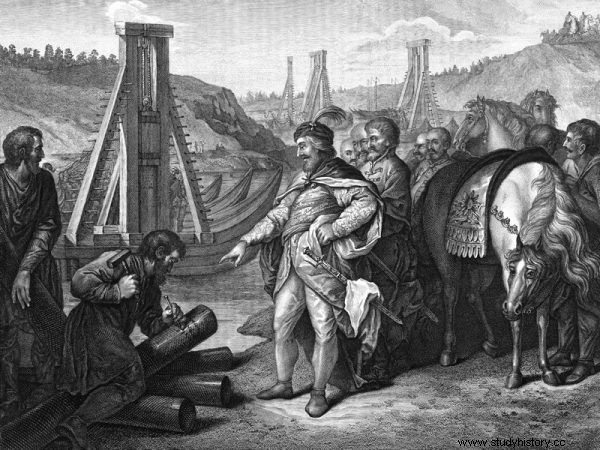
Bolesław the Brave not only drove border posts on the Elbe and Saala, but also placed other degenerates on the Czech throne ... (image from the Vilnius Album by Jan Kazimierz Wilczyński, public domain).
Chrobry helped the latter regain the throne, cynically counting on the ignition of the Czech-Czech war. And he was not wrong. Shortly thereafter, a legation of Czech nobles came to him asking for help in the fight against the psychopath. The Polish prince imprisoned a relative and blinded him , after which he left for Prague, the inhabitants of which proclaimed him a prince. Since the opponents were eliminated, the son of a Czech woman, Dobrawa, had (at least in his own opinion) the greatest rights to the throne.
In March 1003, the Polish prince was the real winner. The Piast monarchy absorbed the Piast Empire . A spectacular and temporary success - as early as 1004 Poles had to leave Prague. Chrobry showed, however, that on the back of the pretenders you can climb the throne of a neighboring country (read more about it) .
This article has more than one page. Please select another one below to continue reading.Attention! You are not on the first page of the article. If you want to read from the beginning click here.
6. He was able to show unexpected kindness
To this day, the character of Brave is perceived through the prism of cruel punishments such as the castration of adulterers. A completely different image of this ruler is presented by Bruno of Querfurt in the lives of five martyred brothers who were murdered by bandits in 1003.

Did Bolesław the Brave deserve another nickname:Gracious? In this painting by Piotr Michałowski from around 1837, we can see his entry into Kiev (source:public domain).
The killers were captured and imprisoned. One might expect a cruel death to happen to them . Meanwhile, they were directed to a monastery to serve the monks who came to the place of the murdered. This is how they were supposed to atone. Though they committed a terrible crime, they were given a chance to attain eternal life.
Where did Brave's decision come from? It turns out that he drew on the customs developed in Western Europe in the Carolingian era. According to them, the murder of clergy was punished with penance in the monastery. This shows that Bolesław ambitiously introduced the standards of the "old Christian" civilization to the Vistula River (read more on this topic) .
5. He let the comet lead it to success
When it shone in the sky in 1018, it was written all over the world:in Japan, Korea, and Germany. Bolesław the Brave also looked hopefully at the sky adorned with a bloody glow. Here God himself illuminated his way east and called him to deal with his enemies.
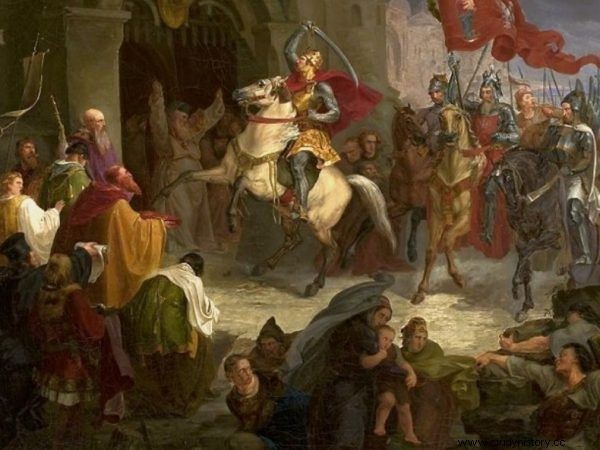
Led by a comet, Bolesław reached the gates of Kiev. The painting by Wincenty Smokowski, created in the 1830s (source:public domain).
On August 9, the comet lowered its flight, flooding the sky with ominous light. On August 13, its glow grew even stronger. Bolesław's army was already in the outskirts of Kiev. There must have been a common perception that the "broom-shaped star" was a harbinger of the success that awaits them the next day.
Indeed, the omen could not have been more favorable. Bolesław achieved a triumph that even the emperors of Byzantium were not capable of. On August 14, 1018, Kyiv, a huge metropolis, was in the hands of the Duke of Poland. Chrobry entered the council of Saint Sofia to sit on the throne of the princes of Rus (read more about it) .
4. He was a disgusting rapist
Gallus Anonymus told eloquently that when Bolesław took the capital of Rus, he immediately dragged one of the sisters of the local prince, Przedsława, to the bed room. The monk wrote directly that the ruler raped her in the same way as he had previously dented the gate leading to Kiev with his sword.

Bolesław's shameful act was not the only or the first in that period. Presław's father, Włodzimierz, also raped her mother before he married her. Picture by Anton Łosienka, 1700 (source:public domain).
Some scientists, however, deny that any rape has taken place. They treat Gall Anonim's text as a fairy tale, forgetting that the history of the Pre-Slava was known to other authors. After all, one reflection is permanent. Regardless of whether a given specialist believes that the Ruthenian princess was taken by force or not, the story itself is treated as a peculiar phenomenon.
The sad truth was quite different. Rape was neither rare nor unusual a thousand years ago. Even the best-born, wealthy and politically empowered ladies could not delude themselves that in the event of war they would remain safe. Their bodies were a reward for the invaders, as was the gold stored in the chests (read more about this) .
3. He led to the curse on Poland
At the end of Bolesław's reign, Archbishop Radzim Gaudenty made the country anathema. All churches were to be closed and no mass was allowed or the sacraments were administered. Brave, as the ruler of a cursed country, lost the trust of his immediate surroundings, and in the eyes of Christian Europe he became a second pagan.

Casting his curse, Gaudenty undoubtedly made sure that the most influential people in the country of the first Piasts appeared in the cathedral (source:public domain).
In all likelihood it was the ruler that Gaudent's curse was inflicted on. An archbishop whom the prince had humiliated and ignored for several years. An opportunity for revenge came when Bolesław brought himself a concubine, Przedsława, from his expedition to Kyiv, despite the fact that his legal wife - Oda - was waiting for him at home.
The excommunication was justified by bigamy. The Christian chief, who sentenced other adulterers to public castration, brought himself a captive, forgetting about his wedding wife. He lived with two wives. And they led him to his downfall. The curse of Gaudenty was also the curse of Oda and Preslava (read more about it) .
This article has more than one page. Please select another one below to continue reading.Attention! You are not on the first page of the article. If you want to read from the beginning click here.
2. He wanted to be emperor
It has been assumed that Bolesław the Brave waited for the royal crown for a quarter of a century - from the convention in Gniezno until 1025. He, however, although he only received a promise of elevation to the rank of monarch from Otto III, ordered him to be called king on coins. And in his own opinion, he was even more important.
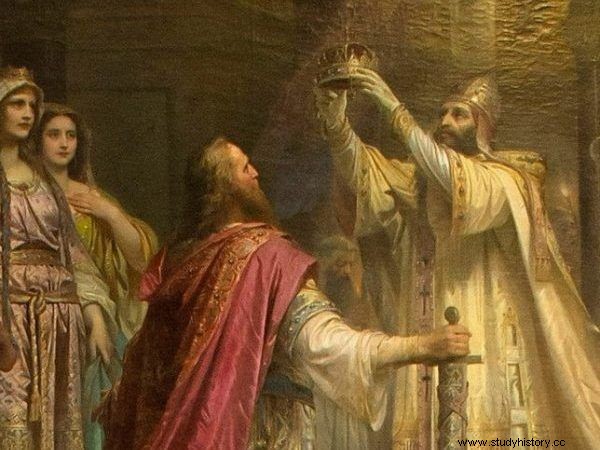
This was the imperial coronation of Charlemagne. Could a similar ceremony take place in Poznań or Gniezno? Fragment of a painting by Friedrich Kaulbach (source:public domain).
Gall Anonim in his chronicle presented Bolesław as a ruler equal to the German emperors. He stated emphatically that already during the Congress of Gniezno the Polish prince behaved almost like ... the emperor! Gestures, gifts, splendor ... all elements of the description contained in the "Polish Chronicle" create the image of a ruler who aspires to the title of "Emperor of the Slavs".
There are also historians who attribute imperial plans to Brave. Hungarian medievalist György Györffy wrote directly that "after the death of Otto III" he made an attempt to "unite the Western Slavs under his own scepter" . The continent's third empire, however, was not established (read more on that) .
1. His name was not Chrobry
Seemingly, the term "Chrobry" was taken from a reliable source. They can be found in the pages of the first Polish chronicle by Gall Anonym. It also falls in the monarch's tombstone epitaph. The problem is that both texts - at least in the fragments of interest to us - are not authentic.
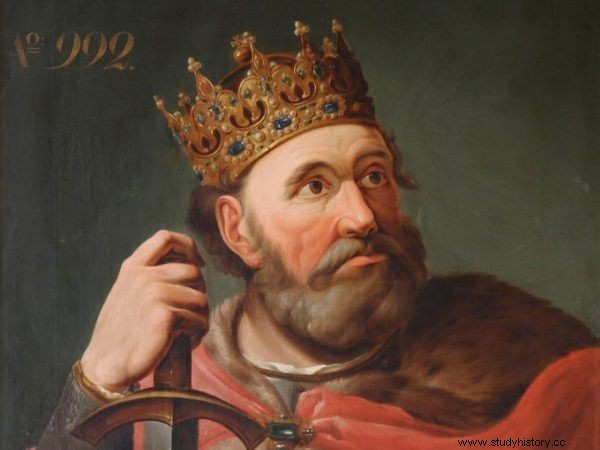
What Bolesław? Intrepid? Large? Perhaps Magnificent after all? The first Polish king in the painting by Jan Bogumił Jakobi from 1828 (source:public domain).
In the chronicle, Gall consistently referred to Bolesław as "Magnus", that is, the Great. He only broke off once when, on the occasion of his death, he described the king as "Gloriosus" - "the Magnificent." Chrobry appears only in the title of one of the chapters. This headline is certainly not from Gall, but has been added by a copyist. The fragment of the epitaph is a late addition, probably introduced during the renovation of the tomb.
What is characteristic of the name of "Chrobry", was also unknown to Wincenty Kadłubek. Because there was no such nickname then. The first one appears only in Kronika Wielkopolska, written almost three hundred years after the death of King Bolesław! And it was from there that he began to infiltrate the above-mentioned sources. It seems that throughout almost the entire Middle Ages, Bolesław was referred to as "the Great" or "the Great" (read more on this topic) .
